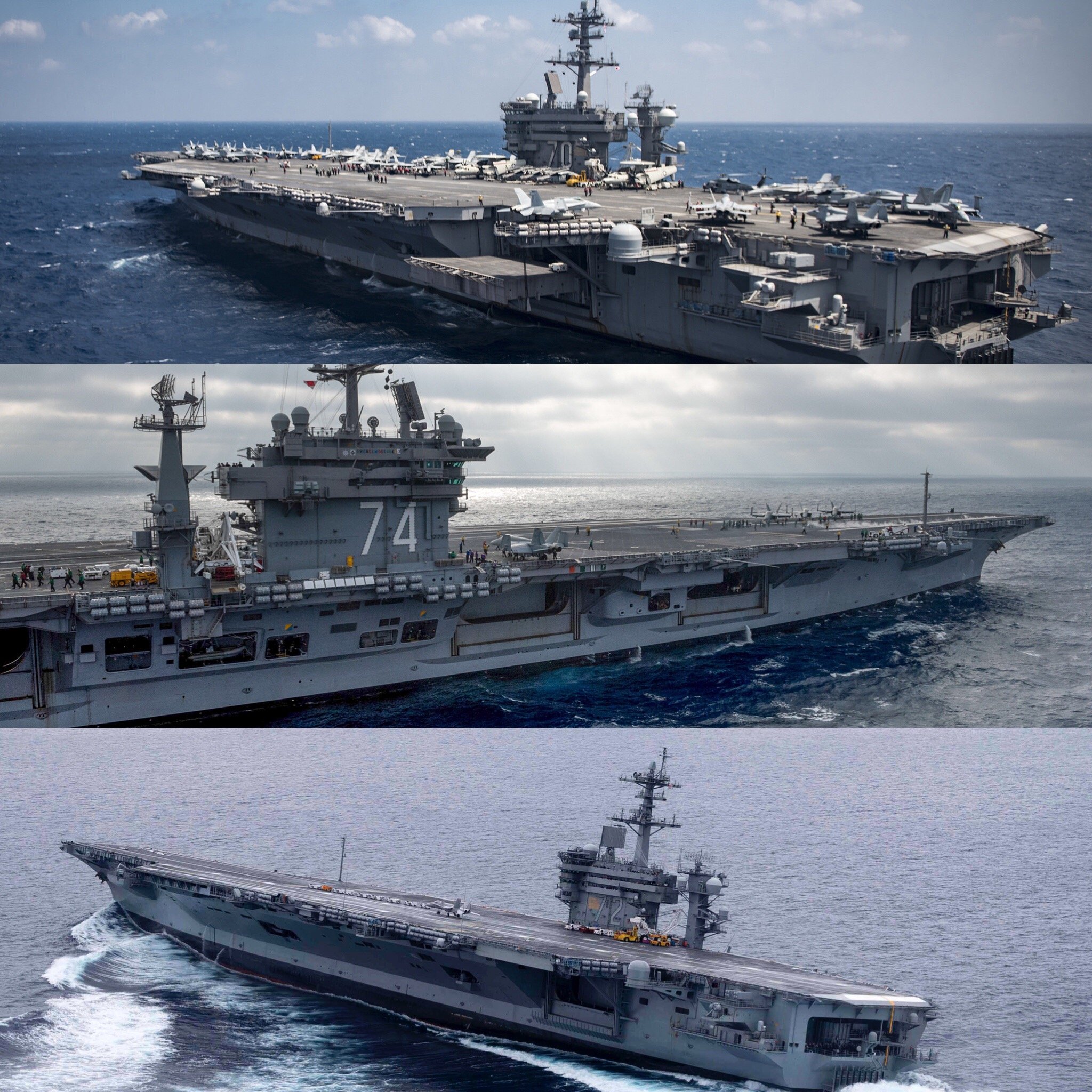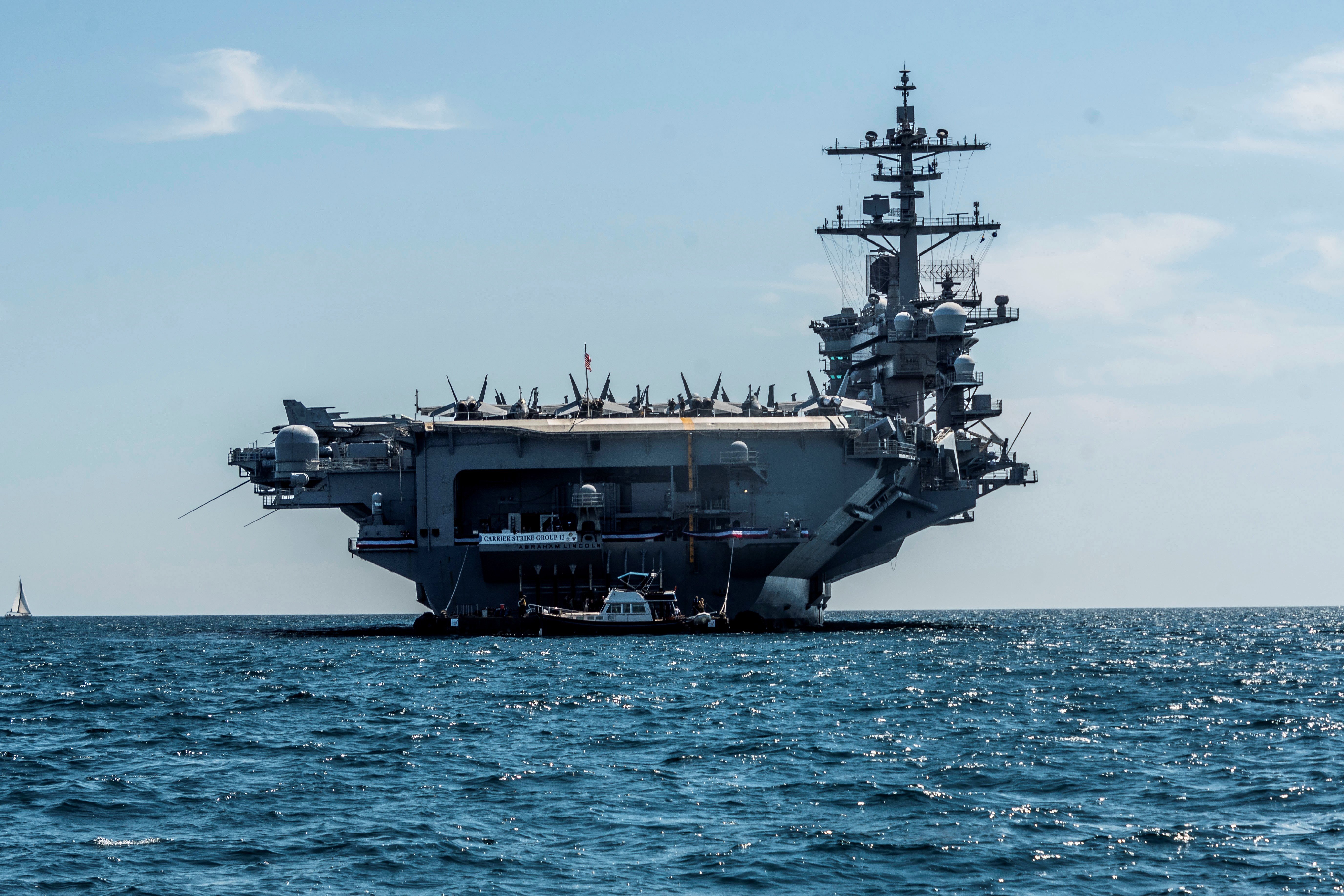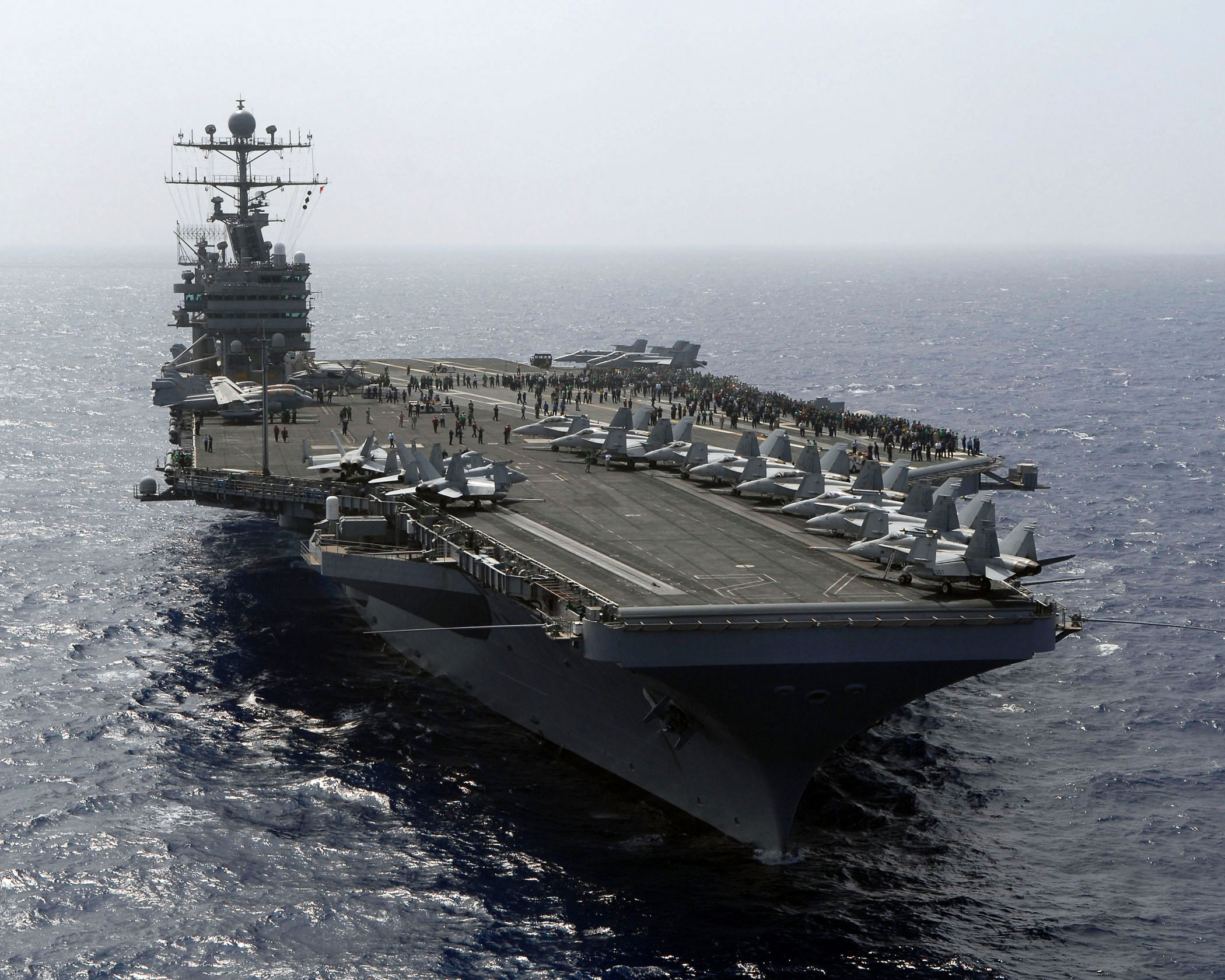Aircraft Carrier Lincoln - Lincoln's destroyer escorts – USS Bainbridge (DDG-96), USS Mason (DDG-87) and USS Nitze (DDG-94) – departed the Middle East in the fall and returned to Norfolk on Nov. 5. Cruiser USS Leyte Gulf (CG-55) remained in the Middle East longer and just returned to Norfolk over the weekend, on Jan.
4. Often the presence of an aircraft carrier has deterred potential adversaries from striking against U.S. interests. Aircraft Carriers support and operate aircraft that engage in attacks on airborne, afloat and ashore targets that threaten free use of the sea;
Aircraft Carrier Lincoln

and engage in sustained power projection operations in support of the U.S. and coalition forces. The Ticonderoga-class guided-missile cruiser USS Chancellorsville (CG 62) breaks away from the Nimitz-class aircraft carrier USS Abraham Lincoln (CVN 72) after escorting Lincoln through the U.S.
7th Fleet area of operations. Chancellorsville is forward-deployed to the U.S. 7th Fleet area of operations in support of security and stability in the Indo-Pacific region. US Navy photo. “We spent a lot of time maneuvering around not only the Philippine Sea, but also in the South China Sea and well as the East China Sea.
And the dynamic maneuver wasn't just exclusively maneuvering around to avoid certain things, but it was also that that's our best way of being able to compete in that space, as well as providing a strong presence throughout the region,” Anderson said.
"If we were to just simply maintain our location in one general location, I don't think we were necessarily doing our job, right, in terms of providing a sustained presence throughout the region." “We took onboard a lot of their lessons about ... where to base, and how to operate.
We did build upon those lessons and learned a few of our own. We were fairly fortunate in that while we covered a vast amount of space in 7th fleet – some days it was a long flight for the CODSPREY – but we were able to remain mostly based out of one location for most of the deployment, which at least
facilitated the flow of people and parts to one location,” Bauernschmidt said. The 10 nuclear powered Nimitz class aircraft carriers are the largest warships in the world, each designed for an approximately 50 year service life with one mid-life refueling.
USS NIMITZ (CVN 68), USS DWIGHT D. EISENHOWER (CVN 69), USS CARL VINSON (CVN 70), and USS THEODORE ROOSEVELT (CVN 71) have all completed their Refueling Complex Overhauls (RCOH) at Newport News, Va. with USS ABRAHAM LINCOLN (CVN 72) having commenced RCOH in 2013.

Aviation Boatswain's Mate (Equipment) 2nd Class Justin Mancha, from San Antonio, signals an F-35C Lightning II, assigned to the 'Black Knights' of Marine Fighter Attack Squadron (VMFA) 314, as it takes off from the flight deck of the
Nimitz-class aircraft carrier USS Abraham Lincoln (CVN 72) during Rim of the Pacific (RIMPAC) 2022 on July 14, 2022. US Navy Photo The aircraft carrier and its strike group also engage in maritime security operations to interdict threats to merchant shipping and prevent the use of the seas for terrorism and piracy.
Aircraft carriers also provide unique capabilities for disaster response and humanitarian assistance. The embarked carrier air wing provides helicopters for direct support and C4I assets to support them and ensure aid is routed quickly and safely.
The ship departed Norfolk, Va., for a deployment and homeport change on April 1. Including today, the ship has been deployed for 283 days – just one week shy of the post-Vietnam War carrier deployment record of 290 days, according to USNI
News records. The deployment has included operations in U.S. 6th Fleet, U.S. 5th Fleet, U.S. 7th Fleet, and now U.S. 3rd Fleet. An F/A-18E Super Hornet, assigned to the 'Tophatters' of Strike Fighter Squadron (VFA) 14, prepares to make an arrested landing on the flight deck of the Nimitz-class aircraft carrier USS Abraham Lincoln (CVN-72) on
June 3, 2022. US Navy Photo Cmdr. Daniel Hutton, an aircraft intermediate maintenance department officer aboard Lincoln, said the carrier's crew used takeaways from the Vinson deployment to tweak what equipment Lincoln brought. This allowed the crew to make more space in the hangar bay and be more strategic with what equipment it needed or did not need.
As a result, the crew placed more gear in hangar bay 3, which made for more space in the middle of the carrier and in the forward part of the ship. “It's the tremendous capability that the aircraft provides from an ability to generate information, the sensors that it has onboard, as well as its ability to distribute that information, not just to other aircraft but to the rest of the force,” Anderson told USNI
News. “It's a testament to the platform and the folks that fly it too that it can integrate so well in with the rest of the air wing. We don't have to do unique things with the schedule, the cycle lengths, etc.

in order to accommodate it.” USS Harry S. Truman (CVN-75) was sidelined in late August, just before its planned deployment to relieve Lincoln, due to electrical system malfunctions. Lincoln remained on station in the Middle East until Truman arrived in the U.S.
Central Command waters in mid-December. Ship spotters put Lincoln in Pearl Harbor today, and a Navy news release later confirmed the location. U.S. 3rd Fleet could not comment on future ship operations, including how long the carrier might stay in Hawaii and when it would head home to San Diego – and therefore if Lincoln was likely to crack the record or not.
“I think like any new platform that's introduced, there's a little bit of angst about how it's going to go. And I think what ended up happening when we got them was the realization that it was again a fairly seamless integration, regardless of whether it was Marine Corps or Navy,” she said.
But I think in terms of the noise and some of the things they were concerned about from whether it was a deck density standpoint, or parts availability, or maintenance that they were going to be required to do, I think there were a lot more
concerns that were fairly unfounded once, you know, now that we've gotten through this deployment [and] we've been able to see and operate with them.” Once its own escorts left the Middle East, Lincoln was supported by the Truman Carrier Strike Group's destroyers while in 5th Fleet and then by Japan-based USS Chancellorsville (CG-62) during the carrier's transit through the Pacific to its new homeport of San Diego
, Calif. Chancellorsville remained with Lincoln through at least Jan. 4, when the ship was already in U.S. 3rd Fleet waters. The next generation of aircraft carrier, the Gerald R. Ford class (CVN 78) was ordered in 2008 and is slated to be delivered in 2016 as the force structure replacement for USS ENTERPRISE (EX-CVN 65) which was inactivated in 2012.
Instead of basing out of the U.S. Air Force's Kadena Air Base on Okinawa, like Vinson's CMV-22B Osprey detachment, Lincoln's detachment was based out of Marine Corps Air Station Futenma. This helped with parts and maintenance because the U.S.
Marine Corps' MV-22B Ospreys were also at Futenma. "Being the second air wing ship team to go out to sea with that type of aircraft, there's a constant learning process that takes place between the ship, the supporting entities ashore, and then being able to adjust and take into account what things break,

Hutton told USNI News. While the carrier participated in a wide range of exercises, the deployment also marked the first U.S. Marine Corps F-35C Lightning II Joint Strike Fighter squadron deployment on an aircraft carrier and the second for the CMV-22B Osprey.
“He talked about some of the pluses and minuses with different locations – impacts of sea space, or how flight operations worked. We try to ensure that we were postured very well to be able to react to anything that we needed to react, like we do every day," Bauernschmidt said.
“But when you're alongside another ship, we were very careful about planning it so that we were – several times we launched aircraft while we were alongside replenishing to be able to respond as necessary and then we were able to continue about the mission.
" "I am proud of all of the hard work and dedication shown by the entire crew throughout the deployment," Capt. Walter Slaughter, Abraham Lincoln's commanding officer, said in a Navy news release. “Hawaii is a strategic, historic location that presents a well-deserved opportunity for rest and relaxation, and for the crew to honor the sacrifices of those who have gone before us during the attack on Pearl Harbor.”
“I would say a vast majority of folks that have deployed in the Navy got very comfortable and used to 5th Fleet operations and this is obviously not 5th Fleet operations. And so it is a much larger area than we would typically operate in and … it's not just about one entity.
It's about China, Russia, [North] Korea. It's about multiple different actors and being able to respond to any of those,” she told USNI News. "Because it's a large area of operations, being able to strategically place yourself to answer whatever mission we're called upon is very important."
An CMV-22B Osprey, carrying the U.S. ambassador to Japan, Hon. Rahm Emanuel, Japan Minister of Foreign Affairs, Hayashi Yoshima, Commander, U.S. 7th Fleet, Vice Adm. Karl Thomas, Commander, Navy Region Japan/Commander, U.S. Naval Forces Japan Rear Adm.
Carl Lahti, lands on Naval Air Facility (NAF) Atsugi following an official visit, to the Nimitz-class aircraft carrier USS Abraham Lincoln (CVN-72) on April 23, 2022. US Navy Photo "Because we had a lot of Vinson's lessons learned, we were able to sit down and take a very thoughtful look at how we were utilizing space in the hangar bay to try to ensure that we didn't have anything we didn't need,
/cloudfront-us-east-2.images.arcpublishing.com/reuters/JVIT5Y3B75LCTBWZF46N2FBJNU.jpg)
but we did have everything that we were going to need so that it opened up extra space for aircraft and a little bit of extra maneuver space to maneuver them around,” she said. “And we got our deck density down quite a bit from where Vinson was and into a pretty good place.
And then we were still able to provide a little bit more feedback for follow on carriers so that they can learn from what we kind of figured out as well.” “We also took a good look at all of the support equipment and really tried to optimize where maybe we had duplicates, or we had the ability to truly ensure that the support equipment for the aircraft that we had was the right quantity, the right number
, and the right ability,” Bauernschmidt added. Lincoln's deployment to the western Pacific followed a similar one last year by Vinson, which sent the first U.S. Navy F-35C squadron and CMV-22B Osprey squadron out to sea.
Lincoln deployed with 10 Marine Corps F-35Cs that make up the “Black Knights” of Marine Strike Fighter Squadron (VMFA) 314 out of Marine Corps Air Station Miramar, Calif. "Our activities into the South China Sea as well as East China Sea were important to send a signal to China, North Korea, Russia of our commitment to the region, as well as our willingness to fly, sail, or operate wherever international law allows
,” Rear Adm. J.T. Anderson, the commander of Carrier Strike Group Three, told USNI news in a recent interview. "I personally also had to think a little differently about each and every night what the sea space looked like, what we were being tasked with, what we were being asked to accomplish, or to just think ahead about where we may want to position ourselves
in the event we were tasked with a different mission,” she said. "Because unlike operations in the 5th Fleet that you can get where you need to be in half a day, in a fairly short amount of time, we have a lot more sea space to cover.
And so being able to think strategically, position yourself where you need to be, understand the constraints and the restraints of ourselves, our aircraft, and other forces was important.” Since Vinson's crew had the chance to test out the deck density aboard the carrier with the Navy F-35Cs and the CMV-22B Ospreys, Lincoln could take those lessons and alter what they brought to sea.
As a result, Bauernschmidt said Lincoln decreased its deck density. Lincoln deployed with a strike group of surface ships that have all since returned back to Norfolk, while the carrier remained in U.S. 5th Fleet outside the Persian Gulf as tensions with Iran have remained high since May.

Lincoln rushed to the North Arabian Sea in May when tensions first ratcheted up, and it remained there outside the Persian Gulf until a Nov. 19 transit through the Strait of Hormuz and into the Gulf.
ABOARD AIRCRAFT CARRIER USS ABRAHAM LINCOLN, OFF THE COAST OF HAWAII – When aircraft carrier USS Abraham Lincoln (CVN-72) pulls into Naval Air Station North Island on Thursday, it will cap off a busy deployment to the Western Pacific.
According to the Navy, the 290-day deployment for Lincoln was notable in several ways: it was the first deployment of nine months or longer since 1973, it saw the first operational deployment of the F/A-18E Super Hornet, and it led
the Navy's part in the opening days during the “shock and awe” campaign of Operation Iraqi Freedom – where more than 1.3 million pounds of ordnance was dropped in 17 days and a record 21 million gallons of JP-5 jet fuel was used to launch and
recover aircraft 12,673 times. Beyond that, USS America (CVA-66) was deployed for 292 days for the Vietnam War from June 1972 to March 1973. According to USNI News records, all carrier deployments that were longer than 290 days took place during the Vietnam War or earlier.
Anderson echoed remarks Vinson crew members made to USNI News during a trip earlier this year to Vinson at the tail-end of its deployment, in which sailors described a more dynamic environment in U.S. 7th Fleet compared to deployments over the last two decades in U.S.
Central Command.
uss abraham lincoln deployment schedule, where is the uss abraham lincoln today, uss abraham lincoln aircraft carrier, uss abraham lincoln current deployment, uss abraham lincoln news, abraham lincoln aircraft carrier news, uss abraham lincoln, current us aircraft carriers in service